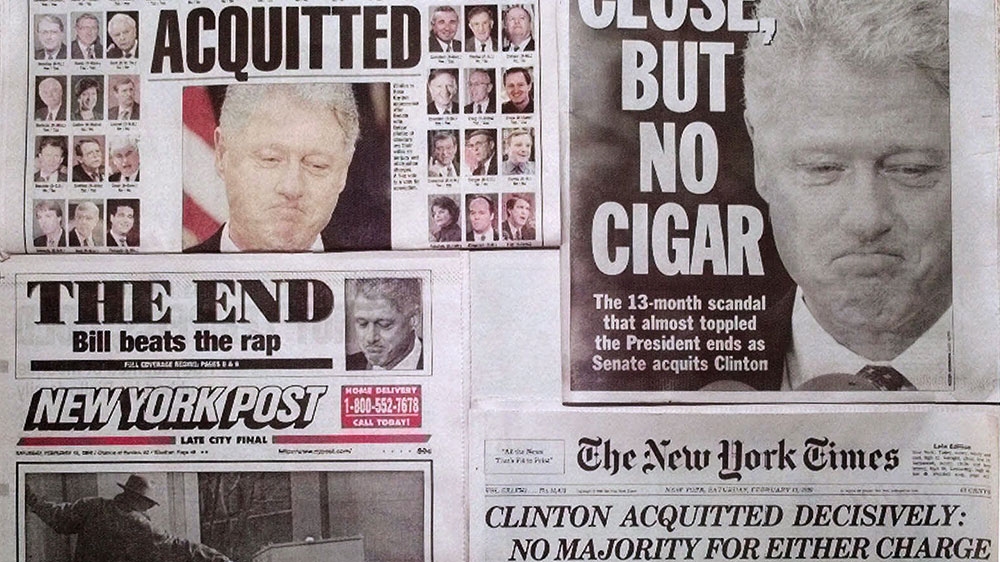What happened in the Senate impeachment trial of Bill Clinton?
As Trump’s Senate trial gets under way, Republicans see precedent set in Clinton trial as a model for proceedings.

President Donald Trump is the third president in United States history to face an impeachment trial in the Senate, and only the second in the last 150 years.
Former President Bill Clinton, the 42nd US president, was tried and acquitted by the Senate in 1999. Senate Republicans are now looking to Clinton’s case for guiding precedents for handling Trump’s trial.
Keep reading
list of 3 itemsWatchdog: White House broke law by withholding Ukraine aid
Democrats release new documents ahead of Trump impeachment trial
Republicans who control the US Senate by a 53-47 majority over Democrats plan to use the impeachment trial of Clinton as the model for the trial Trump.
In an extraordinarily controversial political episode, Clinton was impeached by the House of Representatives in December 1998. He had been the subject of a four-year, wide-ranging investigation by Special Counsel Kenneth Starr, who will be a member of Trump’s defence team in the upcoming Senate trial.
Initially, Starr was commissioned to look into the president and First Lady Hillary Clinton’s involvement with a fraudulent land development in Arkansas while Clinton had been governor of the state.
The inquiry expanded to cover, among other matters, the president’s conduct in a sexual harassment suit filed by Paula Jones, a former Arkansas state employee.

During the investigation, Clinton lied under oath about having a sexual affair with a White House intern, Monica Lewinsky.
Special Counsel Starr issued a 211-page report with a voluminous appendix of underlying evidence to Congress detailing Clinton’s affair with Lewinsky in October 1998.
The House of Representatives, led by then-Speaker Newt Gingrich, quickly initiated an impeachment inquiry (A star in the Republican Party, Gingrich would soon resign from Congress amid Republican losses in the November 1998 election and a scandal of his own over an affair he was having with a congressional staff aide).
The House voted on December 19, 1998, to approve two articles of impeachment against Clinton for perjury and obstruction of justice. Two other articles were defeated in the House.
The day Clinton was impeached by the House was an electric moment in US history.
Even as the House was debating the articles of impeachment against Clinton, then-Speaker Bob Livingston – who had replaced Gingrich – stunned his Republican colleagues by resigning, himself caught in past extramarital affairs.
Meanwhile, the US had bombed Iraq for four days to punish Saddam Hussein for allegedly obstructing United Nations weapons inspectors. It was the heaviest US bombing of Iraq since the 1991 Gulf War presaged the US invasion in 2003.
The trial
The Senate trial began on January 7, 1999, with the ceremonial swearing-in of Supreme Court Chief Justice William Rehnquist and swearing-in of senators as jurors.
Senate Majority Leader Trent Lott, a Republican, and Minority Leader Tom Daschle, a Democrat, negotiated an agreement for how the trial was to proceed. That agreement was supported by all 100 senators.
At the time, Republicans who were the opposition to Clinton controlled a 55-45 majority in the Senate. That is the opposite of today’s political alignment in which Democrats, Trump’s opposition, are in the minority.
Under the rules deal in the Clinton trial, the House had three days to present its case, the president’s defence team had three days for its rebuttal and there were two days of answers to written questions submitted by senators.

Then, as now, there was a controversy regarding whether additional witnesses would be called. The Senate voted 56-44 to seek depositions from Lewinsky and two Clinton aides.
House prosecutors questioned Lewinsky behind closed doors and video excerpts of her testimony were played during final summations.
Deliberating in secret after rejecting a “sunshine” proposal to open the proceedings to public view, the Senate acquitted Clinton.
Ten Republicans joined all 45 Democrats to reject the article of impeachment for perjury. The Senate split 50-50 on the question of obstruction of justice.
Under the Constitution, a 67-vote majority would have been required to convict and remove Clinton, who finished his second four-year term and was succeeded by President George W Bush, a Republican, in 2001.